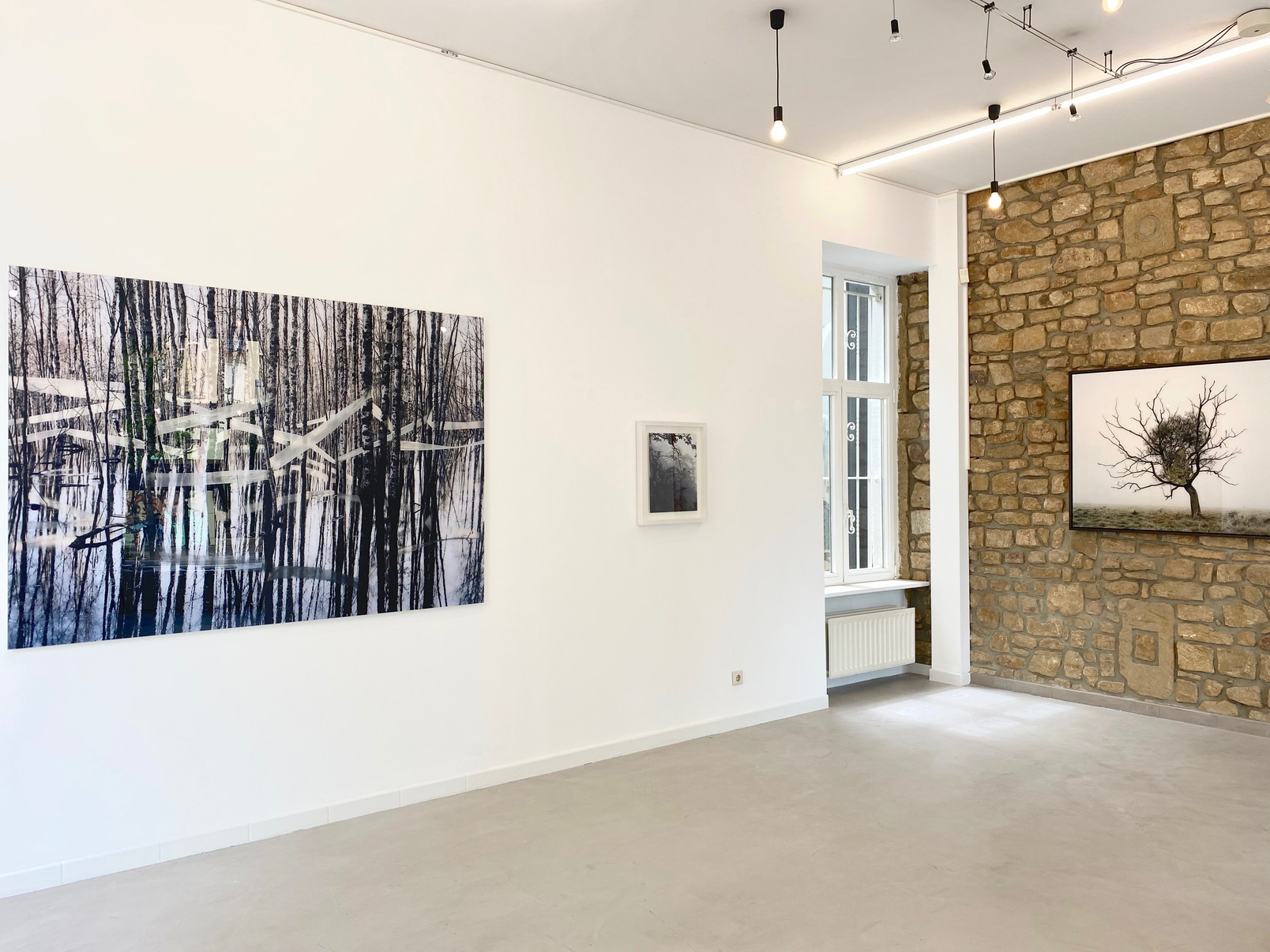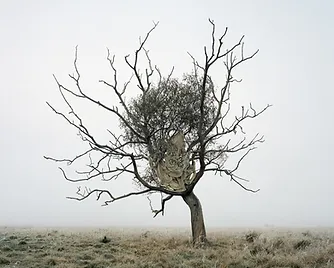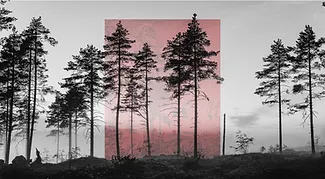
Jaakko Kahılanıemı, Sandra Kantanen, Rııtta Paıvalaınen
In their first exhibition in Luxembourg curated by Yasemin Elçi, Helsinki School artists Sandra Kantanen, Jaakko Kahilaniemi and Riitta Päiväläinen stimulate new discussions around the suffering relationship between humankind and nature in this current epoque called « Anthropocene », which forms the theme of the European Month of Photography. Featured in over a hundred international publications and exhibitions, the Helsinki School is one of the rare photographic movements with lasting impact.
Päiväläinen represents humankind’s entanglement with nature through her metaphoric “sculptural spaces”, installations of fabric dancing with nature. Kahilaniemi makes the first attempt to build a relationship with his future inheritance, by dissecting and reassembling 100 hectares of forest. Kantanen builds a timeless memoir of fictional, transcendent landscapes, by recreating human intervention on nature.
TAMING NATURE
The artists of the Helsinki School of Photography have started to explore nature around the same time that the Nobel-prize winning atmospheric chemist Paul J. Crutzen popularized the term “Antropocene” – the most recent period in Earth’s history where human activity has a drastic impact on the ecosystem.
In their first exhibition in Luxembourg, Helsinki School artists Sandra Kantanen, Jaakko Kahilaniemi and Riitta Päiväläinen stimulate new discussions around the suffering relationship between humankind and nature in this current epoque called Anthropocene, which forms the theme of the European Month of Photography.
The Helsinki School of Photography describes 6 generations of artists since the 1990s who have graduated from or were involved with the Aalto University in Helsinki. Featured in over a hundred international publications and exhibitions, the Helsinki School is one of the rare photographic movements with lasting impact and one that has turned into an international brand in the art world. Each of these artists challenges the boundaries of photography through associations with other disciplines and through conceptual approaches to intangible subjects such as time and memory.
Sandra Kantanen’s dreamy sceneries oscillate between past and future, real and surreal, eastern and westerns ways of looking at nature. Since she found out that the holy mountains she studied in Chinese landscape painting were ruined by “modern” ways of living, Kantanen decided to create the “idealized picture” in her head, by either overexposing, overlaying or digitally distorting images. Her photographic work points to the passage of time as if a painter left dense brushstrokes on the image in an attempt to confine fleeting light. By recreating human intervention on nature, Kantanen builds a timeless memoir of fictional, transcendent landscapes.
While Sandra Kantanen aims to grasp a shared history, Jaakko Kahilaniemi focuses on his own. The series “100 Hectares of Understanding” by Kahilaniemi may seem to bare objective and scientific elements at first sight; however, it is indeed a personal journey that the artist invites us in. By dissecting and reassembling 100 hectares of forest, Kahilaniemi makes the first attempt to build a relationship with his future inheritance. Through conceptualising documentative pieces, he reclaims the narrative around this land that belonged to his family for generations. His experimental visualisation process transforms a collective asset into a personal statement.
Just like Kahilaniemi, Ritta Päiväläinen does not regard landscape only as an objective phenomenon. However, in contrast to Kahilaniemi, Päiväläinen observes nature through traces of human presence. Humankind’s entanglement with nature is represented through her metaphoric “sculptural spaces”, installations of fabric dancing with nature. Her staged images represent rare moments when the inorganic and the organic seem to exist in harmony with each other. Ultimately, Päiväläinen points to a collective effort of humankind in domesticating the environment.

Riitta Päiväläinen was born in Maaninka, Finland, in 1969. She lives and works in Helsinki. Her work has been presented in several solo and group exhibitions, most recently at the Denver Art Museum (Denver, 2018), The Museum of Photography (Seoul, 2018), Gallery Taik Persons (Berlin, 2018) or the Robert Capa Contemporary Photography Center (Budapest, 2017).
Päiväläinen’s unique works have become internationally renowned through their idiosyncratic language and style based upon her deep sense for story-telling. Essentially, the visual elements of Päiväläinen’s compositions can be boiled down to two: nature, and textiles. By joining them together she creates a stage on which to reenact memories of their passing. She creates deserted atmospheric vistas where intimate stories are lodged, told in a language that feels oddly foreign and familiar at once. The pristine nature, spared from the human activity, becomes Päiväläinen’s playground for an interaction between fabric installations, atmosphere and light.
Image: Riitta Päiväläinen, Crack Willow 2019, from the series Shelter © Courtesy of Persons Projects & Valerius Gallery
Text: © The Helsinki School

Jaakko Kahilaniemi was born in Toijala, Finland, in 1989. He lives and works in Helsinki. Kahilaniemi studied Photography at the Aalto University, School of Arts, Design and Architecture.
Jaakko Kahilaniemi’s 100 Hectares of Understanding series is a conceptual body of work that focuses on his family’s relationship to the nature of forestry, over five generations, and his own personal connection to it. It’s a reflective study of what it means to own and care for a future inheritance of 100 hectares of forest, which in fact he’s not interested in, thus enabling him to step back and see it from a different perspective. He explores the numerous ways in which to interpret the 100 hectares’ meaning for himself.
Image: Jaakko Kahilaniemi, Romanticism and Patriotism Studies (Gallen-Kallela 1896), 2017, © Courtesy of Persons Projects & Valerius Gallery
Text: © The Helsinki School

Sandra Kantanen was born in 1974 in Helsinki, Finland. She lives and works in Hanko, Finland. She studied photography at Aalto University School of Arts, Design and Architecture in Helsinki and at the Central Academy of Fine art, Beijing, China. Kantanen has had several international solo and group exhibitions most recently at Alfred Ehrhardt Stiftung (Berlin, 2018), Denver Art Museum (Denver, 2018), Rovaniemi Art Museum (Rovaniemi, 2017) or Fotografisk Center (Copenhagen, 2017).
Sandra Kantanen has delved within the world of landscape photography for the past two decades. This fascination with creating her idealized surreal sceneries stems from her earlier student days, when she went to China during her master’s studies in 2000. Kantanen states: “I studied Chinese landscape painting and became completely obsessed with the idea of trying to understand their way of looking at nature. I found out that most of the holy mountains that they had been depicting for thousands of years were almost totally destroyed by pollution and tourism.” This notion of what’s real or not has been the driving force within Kantanen’s work ever since.
Image: Sandra Kantanen, Untitled (Forest 7), 2017, © Courtesy of Persons Projects & Valerius Gallery
Text: © The Helsinki School